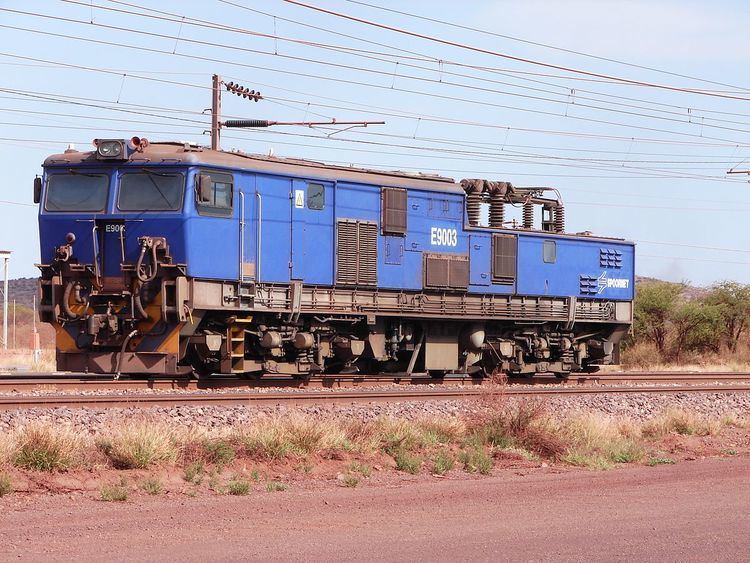Power type Electric Model GEC 9E | Serial number 5546-5570 Build date 1978-1979 | |
 | ||
Designer General Electric Company Builder Union Carriage and Wagon | ||
The South African Railways Class 9E, Series 1 of 1978 is an electric locomotive.
Contents
In 1978 and 1979, the South African Railways placed twenty-five 50 kV AC Class 9E, Series 1 electric locomotives with a Co-Co wheel arrangement in service on the Sishen-Saldanha iron ore export line.
Manufacturer
The 50 kV AC Class 9E, Series 1 electric locomotive was designed for the South African Railways (SAR) by the General Electric Company (GEC) and was built by Union Carriage and Wagon (UCW) in Nigel, Transvaal. UCW delivered twenty-five locomotives in 1978 and 1979, numbered in the range from E9001 to E9025.
Features
The locomotive has a single full width air conditioned cab. At the rear end, the bodywork is lower to provide clearance for the 50 kV AC electrical equipment, which is mounted on the roof. This consists of a single pantograph, a potential divider, a vacuum circuit breaker, a surge diverter and the main transformer’s high voltage terminal. The electrical control system is solid state, using thyristors.
Since huge voltage drops are often encountered between electric sub-stations, the locomotive was designed to be able to operate on a supply varying between 55 and 25 kV AC. The battery boxes and the main air reservoirs are mounted between the bogies beneath the frame, where a compartment houses a small motor scooter, for use by the crew for lineside inspections of the train, which can be up to 4 kilometres (2.5 miles) long.
Series 1 locomotives have four braking systems, air brakes for the locomotive, train air braking, a handbrake and dynamic rheostatic braking which can dissipate 4,200 kilowatts (5,600 horsepower).
By 2007, the entire fleet of both series of Class 9E electric locomotives were upgraded with Alstom's Agate train control and communication technology. The pantographs on most of these locomotives were also replaced by the single arm type.
The Series 1 and Series 2 Class 9Es can be visually distinguished from each other by their bogies, which were redesigned for the Series 2 locomotives.
Service
Class 9E locomotives are used on the 861 kilometres (535 miles) Sishen-Saldanha iron ore line, to haul export ore from the open cast iron mines at Sishen in the Northern Cape to the harbour at Saldanha in the Western Cape. Most of the route is across the hot and dry Northern Cape, but the last 75 kilometres (47 miles) to Saldanha runs parallel to the Atlantic coastline and is subjected to the fog and salt sea air of the West Coast.
In South Africa, the Sishen-Saldanha line is unusual for several reasons.
Mixed power
On the Sishen–Saldanha Orex line, General Electric (GE) Classes 34 series and 43-000 diesel-electric locomotives run consisted to Classes 9E and 15E electric locomotives, to haul the 342 truck iron ore trains. Each truck has a 100-ton capacity and the trains are at least 3.72 kilometres (2.31 miles) in length, powered by mixed consists of Classes 9E and 15E electric and GE type U26C Classes 34-000, 34-400, 34-500 and 34-900 and GE type C30ACi Class 43-000 diesel-electric locomotives.
A Class 9E or Class 15E electric locomotive serves as the master of each mixed electric and diesel-electric consist, with a total of between nine and twelve locomotives per train, twelve being the maximum number allowed. Before the Class 15E was placed in service in 2010, motive power usually consisted of three sets of locomotives, each set made up of one or two Class 9E electrics and one or two Class 34 diesel-electrics, with each set’s leading electric locomotive controlling its respective set of diesel-electrics by means of a slimkabel (smart cable). In effect, each ore train was made up of three separate 114 truck trains consisted together, with the locomotives of all three trains controlled by means of a Locotrol radio distributed power control system by one crew in the leading electric locomotive. A typical train would therefore be made up of locomotive set A, 114 trucks, locomotive set B, 114 trucks, locomotive set C, and 114 trucks.
Some problems were experienced using this configuration, and after a couple of major derailments, the locomotive configuration was changed to four sets, with locomotive set D initially made up of two Class 34 diesel-electric locomotives at the rear end of the train, pushing at between 40% and 50% of tractive power at all times, depending on the grades being traversed. The total maximum number allowed was still between nine and twelve locomotives per train.
As more Class 15Es were delivered and placed in service, Class 9E or Class 15E electrics replaced the pair of Class 34 diesel-electrics in set D. At the same time, the more powerful Classes 15E electric and 43-000 diesel-electric locomotives also made it possible to use as few as seven locomotives per train, with locomotive sets A, B and C each made up of one Class 15E or 9E and one Class 34 or 43-000, and set D of a single Class 9E or 15E.
Illustration
The main picture shows no. E9003 in Spoornet blue livery with solid numbers, at the Erts yard near Kathu on 5 October 2015.
